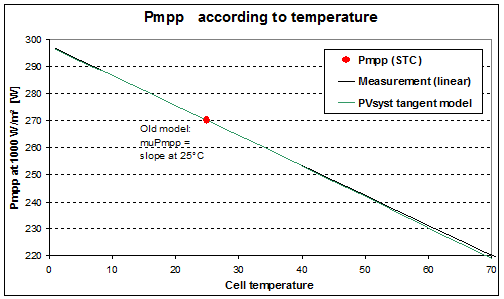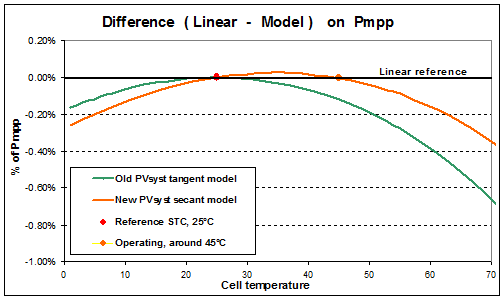Temperature coefficients
The temperature behaviour of the Pmpp, Voc and Isc values (at STC) are usually specified on the manufacturer's datasheets.
In PVsyst we denote by the prefix "mu" or \(\mu\) all temperature coefficients.
muIsc
Often named Alpha, is specified on the main page of the parameters, and used as such in the model. For crystalline modules, its value lies usually between 0.04 and 0.08 %/°C
muVoc
Often named Beta, is a result of the one-diode model. Its value cannot be specified in PVsyst.
Usually the muVoc value of the model will not match the specified value. Don't worry, this is not used in the simulation, which most of the time runs at Vmpp and not Voc !
However this is important during the sizing phase, as this determines the array voltage at low temperature, which should not exceed the absolute maximum voltage of the inverter input or the array voltage admitted for the PV module (usually 1000 V (IEC), except for the US where it may be restricted to 600 V (UL specification).
If you are not satisfied with the muVoc of the one-diode model, you can specify the value of the Datasheets. In the project's definitions, you can decide whether you want to use the manufacturer's or the model's value during sizing.
muPmpp
Often named Gamma, is normally a result of the one-diode model.
The value of the model is usually rather close to the specification.
However it is desirable to use the exact value specified by the manufacturer. For adjusting the Pmpp temperature behaviour of the one-diode model, we have introduced a little correction, which is a linear modification of the Gamma value (diode ideality factor), named \(\mu\)Gamma.
Determination of muGamma
According to the measurements reported by the specialized laboratories, the maximum power point Pmpp behaves very linearly with the temperature.
The muPmpp parameter specified by the manufacturers is the slope of this linear dependence.
Now the Pmpp temperature dependency as calculated by the one-diode model is not exactly linear.
Until Version 6.25, PVsyst adjusted the slope (muGamma) in order to get the correct slope at 25°C (i.e. a tangent adjustment). In these conditions the discrepancy was around -0.03% at 35°C, -0.12% at 45°C and -0.28% at 55°C by respect to the linear hypothesis. The graphics shows that this "error" is almost imperceptible:
Since version 6.26, the slope is adjusted in order to get the measured (linear) value at 25°C and 45°C (i.e. a secant adjustment).
This improves the accuracy of the model at the operating temperatures, and results in a diminution of the temperature loss of about -0.1 to -0.2% (of annual yield) with usual PV systems (depending on the climate and the thermal U-factor)
The graph shows the zoomed differences:
If you are designing plants in very hot climates, you can choose another secant point than 45°C in the Hidden parameters, topic "PV modules", item "Upper temperature reference for muPmpp default". This point should be in the middle range of your operating temperatures along the year, not the highest !
NB: In some places of the program - e.g. in the specification dialog ("Model parameters" / "Temper. coeff.") - the muPmpp value corresponds to the Manufacturer's requirement (i.e. secant).
And in other places (page "Basic data", application of the model), it is the real derivative for a given temperature. Therefore there may be some differences when showing this value.

